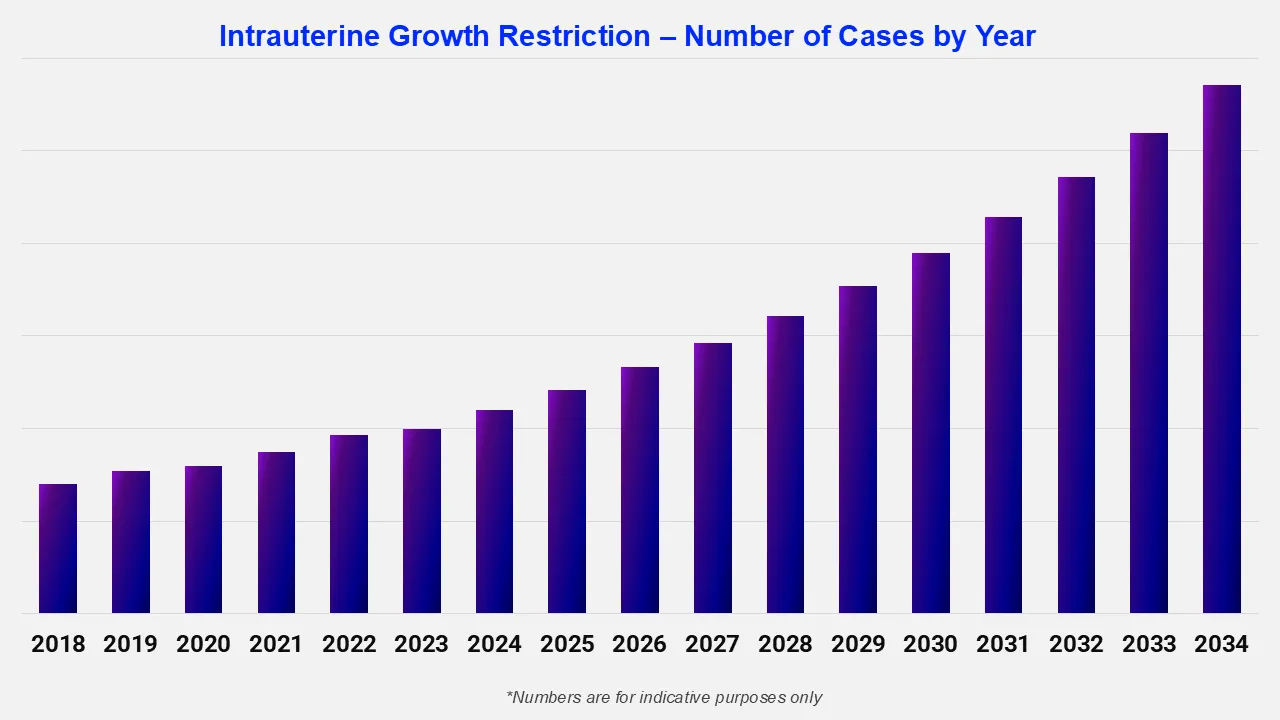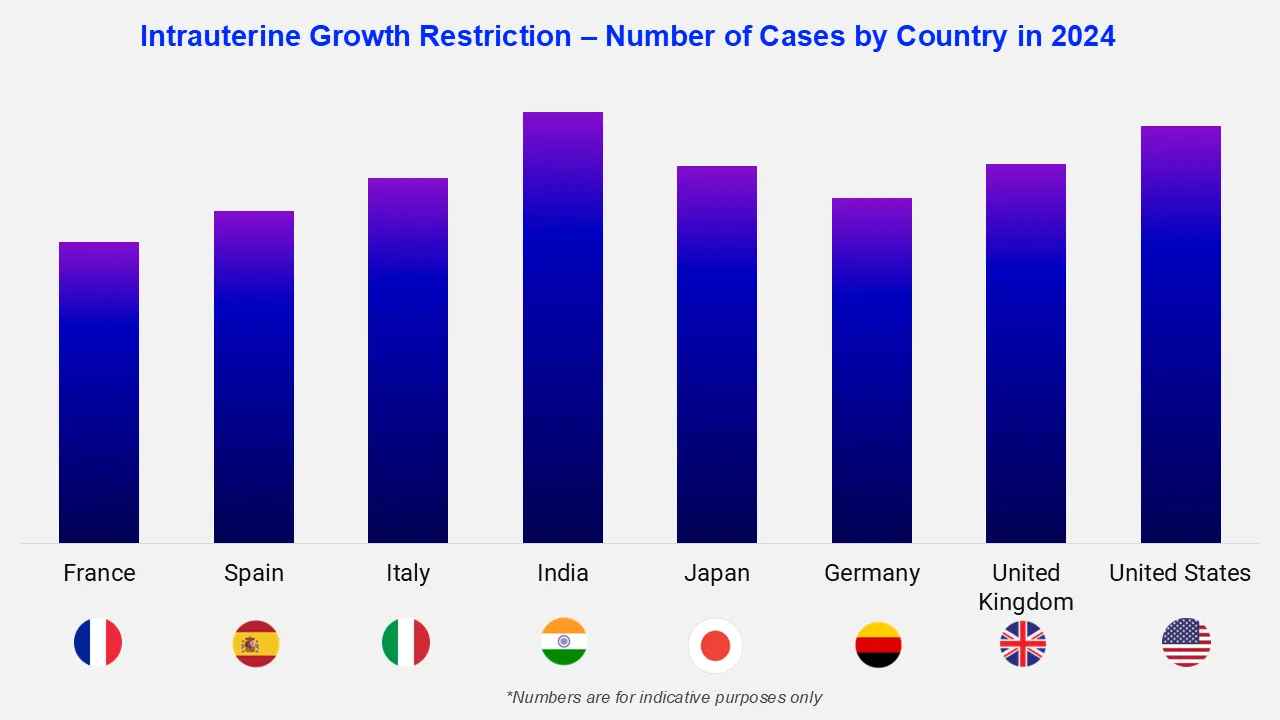
Consumer Insights
Uncover trends and behaviors shaping consumer choices today
Procurement Insights
Optimize your sourcing strategy with key market data
Industry Stats
Stay ahead with the latest trends and market analysis.
Research studies indicate that intrauterine growth restriction affects approximately 10–15% of all pregnancies worldwide. A fetus that is smaller than anticipated for the number of weeks of pregnancy typically weighing less than the 10th percentile is said to have intrauterine growth restriction. This might result in issues throughout pregnancy, delivery, and the postpartum period since it indicates that the baby is not developing normally inside the womb. The intrauterine growth restriction epidemiology forecast report will provide a detailed analysis of the condition's prevalence, incidence patterns, and associated risk factors.
Base Year
Historical Period
Forecast Period

Read more about this report - Request a Free Sample
Expert Market Research's “Intrauterine Growth Restriction Epidemiology Forecast Report 2026-2035” offers comprehensive information on the prevalence and demographics of intrauterine growth restriction. It projects the future incidence and prevalence rates of intrauterine growth restriction cases across various populations. The study covers age, gender, and type as major determinants of the intrauterine growth restriction population. The report highlights patterns in the prevalence of intrauterine growth restriction over time and projects future trends based on multiple variables.
The report provides a comprehensive overview of the disease, as well as historical and projected data on intrauterine growth restriction epidemiology in the 8 major markets.
Regions Covered
Intrauterine growth restriction occurs when a fetus does not reach its genetically determined growth potential while still within the womb. It is clinically recognized when the fetal weight falls below the 10th percentile for gestational age. Intrauterine growth restriction is a clinical indication of several underlying maternal, placental, or fetal diseases rather than an illness in and of itself.
The condition is broadly categorized into two types. Asymmetrical intrauterine growth restriction, which is characterized by a relatively normal head size but a smaller abdominal circumference (usually due to placental insufficiency in the later stages of pregnancy). Symmetrical intrauterine growth restriction is another type of this condition, where the fetus is proportionately small and growth restriction occurs early in pregnancy. Symmetrical intrauterine growth restriction is frequently caused by chromosomal or congenital anomalies.
The intrauterine growth restriction epidemiology division offers information on the patient pool from history to the present as well as the projected trend for each of the 8 major markets. Expert Market Research provides both current and predicted trends for intrauterine growth restriction epidemiology scenario by examining a wide range of studies. Additionally, the report covers the diagnosed patient pool for intrauterine growth restriction and their trends. The intrauterine growth restriction detailed epidemiology segmentation is broken down into specific categories, such as total prevalent cases, and total diagnosed cases across different age groups and patient pools.
According to an article in the American Journal of Obstetrics & Gynecology, there is a higher prevalence of intrauterine growth restriction in female fetuses, even when sex-specific weight criteria are used. According to the study, the risk of growth restriction is influenced by the interaction between maternal weight and fetal sex.

Read more about this report - Request a Free Sample
The intrauterine growth restriction epidemiology data and findings from the United States, Germany, Spain, Italy, France, the United Kingdom, Japan, and India are also provided in the epidemiology section.
The burden of intrauterine growth restriction varies significantly across countries due to differences in socioeconomic conditions, maternal health profiles, access to prenatal care, and healthcare infrastructure. According to an article published in National Center for Biotechnology, Japan reports an intrauterine growth restriction prevalence of approximately 9%, with ongoing initiatives aimed at early detection and intervention.
Treatment for intrauterine growth restriction mostly focuses on careful monitoring and prompt delivery. Doppler blood flow investigations, amniotic fluid levels, and routine ultrasounds to evaluate fetal growth are all part of management. Optimizing maternal health involves treating underlying diseases such as diabetes or hypertension and, if necessary, advising bed rest or better diet. If an early delivery is expected, corticosteroids may occasionally be given to hasten the fetal lung's maturation. The time of delivery is crucial and usually takes place when the dangers to the fetus from a prolonged pregnancy exceed those of preterm birth, frequently through cesarean section in extreme circumstances.




*While we strive to always give you current and accurate information, the numbers depicted on the website are indicative and may differ from the actual numbers in the main report. At Expert Market Research, we aim to bring you the latest insights and trends in the market. Using our analyses and forecasts, stakeholders can understand the market dynamics, navigate challenges, and capitalize on opportunities to make data-driven strategic decisions.*
Get in touch with us for a customized solution tailored to your unique requirements and save upto 35%!
Explore our key highlights of the report and gain a concise overview of key findings, trends, and actionable insights that will empower your strategic decisions.
|
Report Features |
Details |
|
Base Year |
2025 |
|
Historical Period |
2019-2025 |
|
Forecast Period |
2026-2035 |
|
Epidemiology Statistics Provided |
|
|
Segmentation Provided |
|
|
Geographies Covered |
|
Datasheet
One User
USD 1,999
USD 1,799
tax inclusive*
Single User License
One User
USD 2,999
USD 2,699
tax inclusive*
Five User License
Five User
USD 4,399
USD 3,739
tax inclusive*
Corporate License
Unlimited Users
USD 5,799
USD 4,929
tax inclusive*
*Please note that the prices mentioned below are starting prices for each bundle type. Kindly contact our team for further details.*
Flash Bundle
Small Business Bundle
Growth Bundle
Enterprise Bundle
*Please note that the prices mentioned below are starting prices for each bundle type. Kindly contact our team for further details.*
Flash Bundle
Number of Reports: 3
20%
tax inclusive*
Small Business Bundle
Number of Reports: 5
25%
tax inclusive*
Growth Bundle
Number of Reports: 8
30%
tax inclusive*
Enterprise Bundle
Number of Reports: 10
35%
tax inclusive*
How To Order

Select License Type
Choose the right license for your needs and access rights.

Click on ‘Buy Now’
Add the report to your cart with one click and proceed to register.

Select Mode of Payment
Choose a payment option for a secure checkout. You will be redirected accordingly.
Gain insights to stay ahead and seize opportunities.

Get insights & trends for a competitive edge.

Track prices with detailed trend reports.

Analyse trade data for supply chain insights.

Leverage cost reports for smart savings

Enhance supply chain with partnerships.

Connect For More Information
Our expert team of analysts will offer full support and resolve any queries regarding the report, before and after the purchase.
Our expert team of analysts will offer full support and resolve any queries regarding the report, before and after the purchase.
We employ meticulous research methods, blending advanced analytics and expert insights to deliver accurate, actionable industry intelligence, staying ahead of competitors.
Our skilled analysts offer unparalleled competitive advantage with detailed insights on current and emerging markets, ensuring your strategic edge.
We offer an in-depth yet simplified presentation of industry insights and analysis to meet your specific requirements effectively.
Share